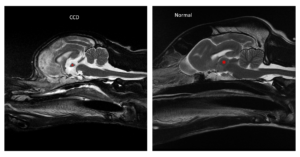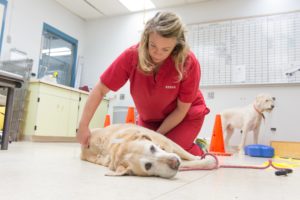As dogs age, so do their brains. And with aging can come cognitive decline, or dog dementia. As health care for companion animals continues to improve, dogs are living longer than they used to, leaving more time and opportunity for cognitive changes to occur. One of the manifestations of cognitive decline is a condition called canine cognitive dysfunction syndrome (CCDS), which is eerily similar to Alzheimer’s Disease in humans.
“Recent research shows that aging changes for dogs as it relates to cognitive decline are remarkably similar to humans that suffer from cognitive changes, specifically Alzheimer’s Disease,” said Dr. Stephanie McGrath, veterinary neurologist at the James L. Voss Veterinary Teaching Hospital.
Canine cognitive dysfunction syndrome occurs in 35% of dogs over eight years old, so if your dog is getting up there in age, it’s important to be on the lookout for signs of dementia and see your veterinarian if you notice any changes. Early recognition of abnormal behavior is essential because diseases like canine cognitive dysfunction syndrome are degenerative. This means that as the disease progresses, the outward clinical signs worsen. Deterioration in the brain is irreversible, emphasizing the importance of catching signs of dog dementia early.
“Oftentimes dogs are diagnosed once they’ve shown a lot of clinical signs, but the ideal time to intervene is earlier on,” said Dr. Lisa Bartner, veterinary neurologist at the James L. Voss Veterinary Teaching Hospital.
Part of the challenge of accurately diagnosing CCDS early is that the more common clinical signs – like personality changes, losing house training, wandering aimlessly at night – often mimic those of other neurological disorders, like brain tumors or other structural brain diseases. These signs often seem vague and happen gradually over the course of several months. Some owners don’t pick up on them until they return home from a vacation or have a houseguest point out a noticeable change.
A helpful tool for identifying behavior changes in animals is the Cognitive Dysfunction Syndrome Assessment Tool, which details the acronym “DISHAA” to outline potential clinical signs a senior pet experiencing cognitive dysfunction syndrome might exhibit.
If clinical signs of dog dementia are recognized, an MRI can help with diagnosis of CCDS. Degenerative brain diseases like canine cognitive dysfunction syndrome literally cause the brain to shrink, which can be captured by an MRI. MRI also helps to exclude other conditions that could impact a dog’s health.

“Most degenerative diseases are progressive, which means the brain atrophies, or shrinks,” Bartner said.
The problem is that brain atrophy is easiest to identify on an MRI scan when cognitive decline is advanced, so once more consistent clinical signs are noticed and later than is ideal for intervention. The further the disease progresses, the less cognitive function there is to try to preserve.
While CCDS is becoming more common, it is often misdiagnosed or undiagnosed by pet owners or their primary care veterinarians because of the slow onset and vague clinical signs, and there’s still not enough discussion or research about the disease in the veterinary world.
“We don’t have an easy way to diagnose it or even a way to diagnose it definitively,” McGrath said. “We’re seeing it more often, but it can be a difficult and frustrating diagnosis for pet owners because there’s no cure.”
Tap into habit
Though there’s no cure, much like with Alzheimer’s, some physical therapy and rehabilitation techniques show promise in helping dogs with dementia maintain quality of life for longer.
“Treatment ends up being, ‘can we preserve what function we have or slow down the progression?’” Bartner said. “Reversibility is limited and there’s no one ‘slam dunk’ treatment, but rehabilitation plays a big role in potentially helping to slow down clinical progression.”
The first step is to alleviate any pain your pet may be experiencing. To be clear, CCDS does not cause pain, but other comorbidities that also worsen with age, like arthritis or achy muscles, can exacerbate signs of cognitive dysfunction.
Once a pain management plan is started or it’s established your dog is not experiencing pain, Sasha Foster, small animal rehabilitation coordinator at the James L. Voss Veterinary Teaching hospital, recommends decreasing the amount of novel activity you’re presenting to your dog while also enforcing a familiar routine.

“Take the ten-thousand-foot view of what your dog does every day – consider what time they wake up, eat breakfast, go for a walk – and then follow those same patterns,” Foster said. “The more repetition of an activity you do, the more it becomes habitual. We’re trying to tap into habit.”
Research in humans shows that when they get regular, low-level exercise, cognitive dysfunction clinical signs improve, including sleep. For dogs, similar coordination, balance, and low-level exercise guided by a rehabilitation specialist seem to improve cognitive dysfunction.
Even if you’re unable to obtain a diagnosis of CCDS, or you’re hesitant to jump into getting an MRI for your pet, “there’s no harm in doing rehab,” Bartner says.
Until researchers can develop better diagnostics and therapeutics, early recognition of abnormal or unusual behavior – and a visit to your veterinarian to investigate the cause – can help slow the progression of cognitive decline and extend the quality-of-life potential for your pet.